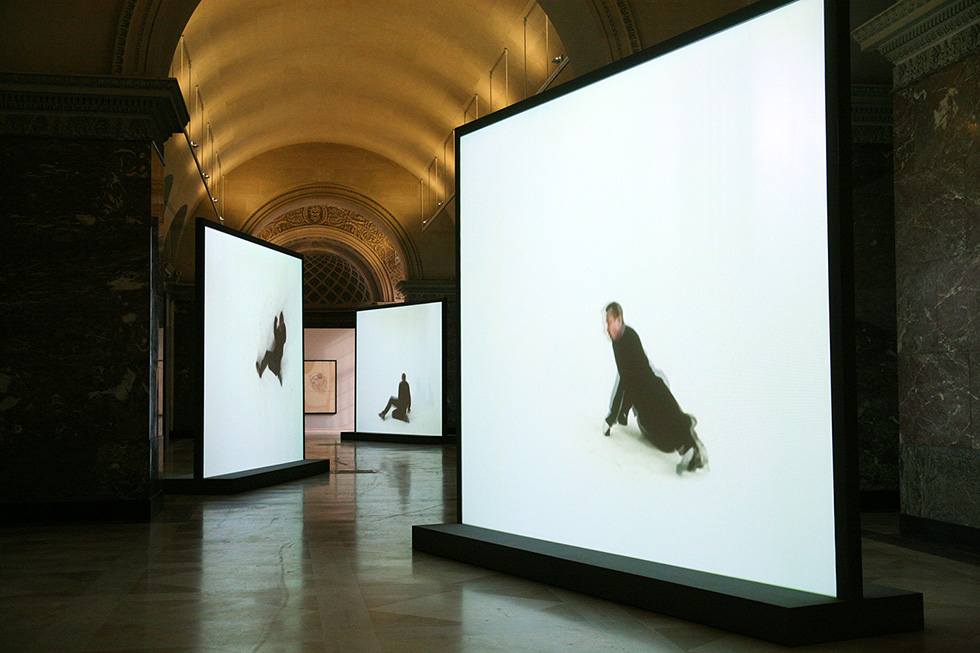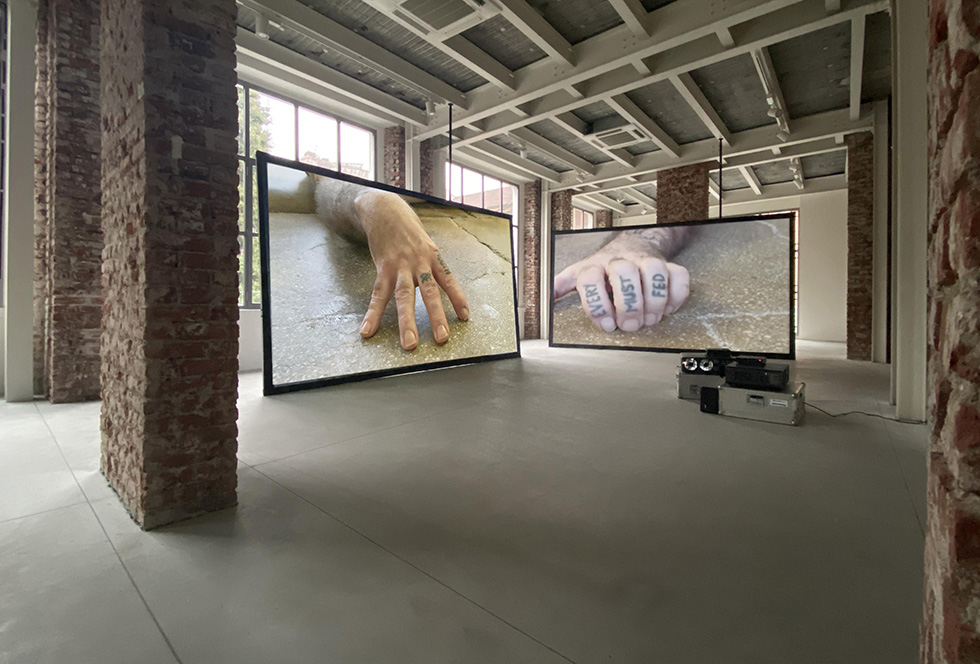01
if the playing child feels the observing other, it is abruptly torn out of its self-forgetfulness. depending on its character, this sudden transition out of another world back into the here and now leads to different reactions. whether joy, anger, shame, or just simple uncertainty arises from the moment, can either be intensified or softened by the observer, according to his reaction. the moment itself, the change of a mental, a possible absent, state into present time forms the basic position in peter welz’ artistic investigations. furthermore, in some of his works he turns back time into the possible moments of abandon, or, in the broadest sense of exuberance.
the role as a present, witnessing second is reluctant and not dialogical, his influence on the scene is limited to the noting technique – the camera. nevertheless, one cannot speak of documentation in his work, since he himself sets the framing conditions, chooses the moment depicted and stages it. however much he may withdraw, he nevertheless remains, if only a hidden shadow, part of the almost scientific scenario. a smoothly spun web between experiment and experimental emerges. the question determines the answer.
the results of his inspections are presented both as large-format video projections and partial excerpts accompanying the work in the form of sketches of ideas or further processed details of his recordings. the viewing public interacts with the artist’s observations and the mesh between artist and depicted is expanded by another level. the observed child at play is observed and a multi-layered cocoon of multibel mirrored emotions develops.
peter welz

02
the autonomous visitor of these orchestrations can move freely in them and leave whensoever. as compressed best-of at rem primetime they constitute the perfect nightmare. a fictitious, accomplished editor arranges a rapid succession of human dramas from welz’s long-term studies. aa bronson intimidated, eyes downcast, douglas gordon, arms crossing the chest again and again, striking sideways and back; monica vitti lost on set and swirling around everything in wild rebellion – william forsythe… we don’t need a gloomy soundtrack to wake up bathed in sweat. the deliberate exaggeration of welz’s artistic catalog seeks to emphasize the obvious: is there a hidden motive, a repressed intention?
the preliminary stage to the uncanny is the subconscious anxiety. it is the manifestation of the eternal human status as flight animal and its uncontrolled mechanisms. once triggered, the hormone-controlled alarm readiness can only be reduced slowly, so to speakback in the pre-digital era. in today’s aseptic world, no longer serving the senses, the field of vision rarely leaves the screen, vehicles whir by silently, onions no longer have a strong smell. in short – the roses no longer have thorns. the human soul, thus starving in his individual shelter, removed from all toil, finally free, should be happy. for the senses seem smeared and the drive clogged, we find ourselfs in home-made cages.
the human condition in welz’s sense touches on maurice merleau-ponty’s thesis, supposing the body actually experiences the world, but refuses any protagonists fulfillment thereby. merleau-ponty’s disciple, emmanuel levinas, argueing the dialogue of the subject with the other grows to ever-increasing asymmetry instead of pacifying it, cannot reach into this closed rubber cell of the self either, since an opposite no longer exists. thus the portrayed stand, turn, twist and stretch themselves in room sized loops and the idea of the playing child coagulates to bacon’s soundless scream. whoever is not already speechless enough by this mental striptease may still observe the artist cutting palm-sized holes in his projection surfaces, only to realize with horror that the projected image penetrating through the opening only meets another foil lying behind it.
game, set, match, crossed eyes emoji.

peter welz
retranslation | final unfinished portrait (francis bacon),
figure inscribing a figure
installation view musée du louvre, paris 2017
03
following this model of thought, one can also change the direction of view of course, in which the child becomes the observer. seen this way, the scenery presented by welz alters completely. embracing his rather boyishly mischievous character, the technical aspect of his worlds finds a suitable explanation; it is not the event that is set in scene only, but the scenery that represents the event as the artist’s expression. the quiet, eerie, shocking and perfect interpretation of figure in space becomes a questioningly groping image filled with innocence and wonder.
taking a closer look at the large-format works by peter welz, common at the beginning of the 21st century, and above all their arrangements, one notices interactions that at first seem random, but on second glance are very precisely related to one another. like a set of dice that comes to lie on the table as it was thrown, the initial effect of the works in the respective exhibitions resembles an abandoned children’s room, a re-enacted second life reveals. this impression is reinforced in view of the projectors showing endless loops of monica vitti, and becomes obvious how welz treats single images of her and subsequently those of douglas gordon.
like a puppet show of our ancestors, whose clothes were cut out and placed around the object, or multifunctional toys, whose individual parts could be exchanged and thus rearranged, the studies created by welz are constantly changing collages in form, color and size. critically argued all studies are steps on the way to finding the artist’s form, but not so with welz. here you find autonomous possibilities of different ways of looking at one and the same object and siblings rather than a searching path for an ideal. leaving the access to both readings open, the artist’s presence is absent.

peter welz
portrait #5 [douglas gordon | take 02]
installation view casa degli artisti, milano 2023
04
when a person meets another, a feeling is created, ideally a memory. the sum of all these memorized events is what we call culture. you don’t have to dive into the mariana trench to fathom even in the deepest depths what happens when contact between people decreases. there will not be less culture as a result, it will simply change. but how are we supposed to interpret the seen if welz not only negates his own presence as an artist and, moreover, thinks of his visual worlds without any subject at all and we are actually facing an empty, emptied frame?
if everything is art, in this sense every intervention in the social space is to be understood as an artistic action, the possibility of activities expands to an infinite field of flight. since the caravan always moves on, tragic crashes in the past are not only quickly forgotten but virtually no longer exist, thus opening the possiblity to bring down the same act in even more absurd situational comedy. if the applause of the uninvolved benevolent is only for the adorned moment, eternity needs no sound recording of it.
nevertheless, peter welz’s observations do not stumble into the abyss of culturally disillusioned whining. if the messenger succeeds in conveying the message unscathed, there is certainly still a need for someone who can not only hear it, but also interpret it correctly. art exhibitions are unfortunately not reproducible and documentations of them can only provide a historical aspect of the presentation, but not its true presence. if the artist declares ‚the presence of absence‘ to be his credo, we as his contemporary witness can decide how we see our own existence reflected in it, or not. go play in the garden child, everything flows, not only the brook there.

peter welz
portrait #4 [aa bronson | single projection | tripple screen] projection screens [240cm x 170cm each], full hd projection, sound casa degli artisti, milano 2020
martin eugen raabenstein, 2023
more at peterwelz.com

peter welz
portrait #3 [out-take | monica vitti | still]
galleria d’arte moderna e contemporanea, ferrara 2019
peter welz
01
if the playing child feels the observing other, it is abruptly torn out of its self-forgetfulness. depending on its character, this sudden transition out of another world back into the here and now leads to different reactions. whether joy, anger, shame, or just simple uncertainty arises from the moment, can either be intensified or softened by the observer, according to his reaction. the moment itself, the change of a mental, a possible absent, state into present time forms the basic position in peter welz’ artistic investigations. furthermore, in some of his works he turns back time into the possible moments of abandon, or, in the broadest sense of exuberance.
the role as a present, witnessing second is reluctant and not dialogical, his influence on the scene is limited to the noting technique – the camera. nevertheless, one cannot speak of documentation in his work, since he himself sets the framing conditions, chooses the moment depicted and stages it. however much he may withdraw, he nevertheless remains, if only a hidden shadow, part of the almost scientific scenario. a smoothly spun web between experiment and experimental emerges. the question determines the answer.
the results of his inspections are presented both as large-format video projections and partial excerpts accompanying the work in the form of sketches of ideas or further processed details of his recordings. the viewing public interacts with the artist’s observations and the mesh between artist and depicted is expanded by another level. the observed child at play is observed and a multi-layered cocoon of multibel mirrored emotions develops.
02
the autonomous visitor of these orchestrations can move freely in them and leave whensoever. as compressed best-of at rem primetime they constitute the perfect nightmare. a fictitious, accomplished editor arranges a rapid succession of human dramas from welz’s long-term studies. aa bronson intimidated, eyes downcast, douglas gordon, arms crossing the chest again and again, striking sideways and back; monica vitti lost on set and swirling around everything in wild rebellion – william forsythe… we don’t need a gloomy soundtrack to wake up bathed in sweat. the deliberate exaggeration of welz’s artistic catalog seeks to emphasize the obvious: is there a hidden motive, a repressed intention?
the preliminary stage to the uncanny is the subconscious anxiety. it is the manifestation of the eternal human status as flight animal and its uncontrolled mechanisms. once triggered, the hormone-controlled alarm readiness can only be reduced slowly, so to speakback in the pre-digital era. in today’s aseptic world, no longer serving the senses, the field of vision rarely leaves the screen, vehicles whir by silently, onions no longer have a strong smell. in short – the roses no longer have thorns. the human soul, thus starving in his individual shelter, removed from all toil, finally free, should be happy. for the senses seem smeared and the drive clogged, we find ourselfs in home-made cages.
the human condition in welz’s sense touches on maurice merleau-ponty’s thesis, supposing the body actually experiences the world, but refuses any protagonists fulfillment thereby. merleau-ponty’s disciple, emmanuel levinas, argueing the dialogue of the subject with the other grows to ever-increasing asymmetry instead of pacifying it, cannot reach into this closed rubber cell of the self either, since an opposite no longer exists. thus the portrayed stand, turn, twist and stretch themselves in room sized loops and the idea of the playing child coagulates to bacon’s soundless scream. whoever is not already speechless enough by this mental striptease may still observe the artist cutting palm-sized holes in his projection surfaces, only to realize with horror that the projected image penetrating through the opening only meets another foil lying behind it.
game, set, match, crossed eyes emoji.
03
following this model of thought, one can also change the direction of view of course, in which the child becomes the observer. seen this way, the scenery presented by welz alters completely. embracing his rather boyishly mischievous character, the technical aspect of his worlds finds a suitable explanation; it is not the event that is set in scene only, but the scenery that represents the event as the artist’s expression. the quiet, eerie, shocking and perfect interpretation of figure in space becomes a questioningly groping image filled with innocence and wonder.
taking a closer look at the large-format works by peter welz, common at the beginning of the 21st century, and above all their arrangements, one notices interactions that at first seem random, but on second glance are very precisely related to one another. like a set of dice that comes to lie on the table as it was thrown, the initial effect of the works in the respective exhibitions resembles an abandoned children’s room, a re-enacted second life reveals. this impression is reinforced in view of the projectors showing endless loops of monica vitti, and becomes obvious how welz treats single images of her and subsequently those of douglas gordon.
like a puppet show of our ancestors, whose clothes were cut out and placed around the object, or multifunctional toys, whose individual parts could be exchanged and thus rearranged, the studies created by welz are constantly changing collages in form, color and size. critically argued all studies are steps on the way to finding the artist’s form, but not so with welz. here you find autonomous possibilities of different ways of looking at one and the same object and siblings rather than a searching path for an ideal. leaving the access to both readings open, the artist’s presence is absent.
04
when a person meets another, a feeling is created, ideally a memory. the sum of all these memorized events is what we call culture. you don’t have to dive into the mariana trench to fathom even in the deepest depths what happens when contact between people decreases. there will not be less culture as a result, it will simply change. but how are we supposed to interpret the seen if welz not only negates his own presence as an artist and, moreover, thinks of his visual worlds without any subject at all and we are actually facing an empty, emptied frame?
if everything is art, in this sense every intervention in the social space is to be understood as an artistic action, the possibility of activities expands to an infinite field of flight. since the caravan always moves on, tragic crashes in the past are not only quickly forgotten but virtually no longer exist, thus opening the possiblity to bring down the same act in even more absurd situational comedy. if the applause of the uninvolved benevolent is only for the adorned moment, eternity needs no sound recording of it.
nevertheless, peter welz’s observations do not stumble into the abyss of culturally disillusioned whining. if the messenger succeeds in conveying the message unscathed, there is certainly still a need for someone who can not only hear it, but also interpret it correctly. art exhibitions are unfortunately not reproducible and documentations of them can only provide a historical aspect of the presentation, but not its true presence. if the artist declares ‚the presence of absence‘ to be his credo, we as his contemporary witness can decide how we see our own existence reflected in it, or not. go play in the garden child, everything flows, not only the brook there.
martin eugen raabenstein, 2023
more at peterwelz.com

peter welz

peter welz
retranslation | final unfinished portrait (francis bacon),
figure inscribing a figure
installation view musée du louvre, paris 2017

peter welz
portrait #5 [douglas gordon | take 02]
installation view casa degli artisti, milano 2023

peter welz
portrait #4 [aa bronson | single projection | tripple screen] projection screens [240cm x 170cm each], full hd projection, sound casa degli artisti, milano 2020

peter welz
portrait #3 [out-take | monica vitti | still]
galleria d’arte moderna e contemporanea, ferrara 2019
